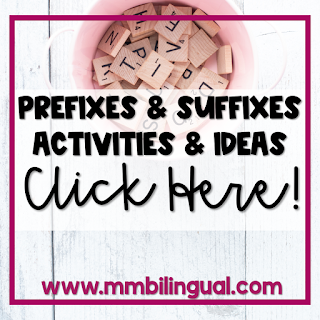Hello friends! One of my favorite things to teach is vocabulary in SPANISH. Prefixes and suffixes in SPANISH are a great way to increase our students' vocabulary. I'll be sharing a few helpful resources and ideas so keep on reading. Feel free to leave a comment below with your favorite vocabulary building strategy. Don't forget to sign up to receive my email newsletter and download this FREE Prefixes unit just for joining!
Why teach prefixes and suffixes? ¿Por qué enseñar los prefijos y sufijos?
Research shows that one of our EL's biggest challenge in reading is due to the lack of sufficient vocabulary. Think about when our students are reading and they come across a difficult word. Some students may just skip right over it, and then the context and comprehension becomes even more of a challenge. Other students may try to break down the word and infer it's meaning. By teaching our students about word parts such as prefixes and suffixes, we are equipping them with strategies to decipher the meanings of new words.
3 steps to teach Prefixes and Suffixes in SPANISH!
Step 1: Create an anchor chart with your students.
It is important to teach the most common and grade level appropriate prefixes and suffixes. First, create an anchor chart or word family chart for each prefix and suffix. You can create anchor charts using these Post-it Super Sticky Easel pads. They will be posted all year round as a reference for your students. On the anchor chart, make sure to include:
- prefix or suffix
- meaning
- plenty of examples
Step 2: Review in small groups
After a whole group lesson, it's time to review prefixes and suffixes in small groups. Students can come to your teacher table and practice hands on activities like the ones mentioned in this blog post. You can use expo markers, sentence strips, highlighting strips, post its, pretty much anything that will get the students excited about deconstructing and reconstructing words.
What does deconstructing and reconstructing words mean?
When deconstructing words use these question prompts:
- What parts do you see in the word?
- What does that part mean?
- Can you find it on the anchor chart?
- Now put this part together with the rest of the word. What does the entire word mean?
When you are working in small groups, have students work on their own or in centers. Some of these centers can include the prefixes and suffixes worksheets I have in this bundle. This bundle includes: anchor charts, interactive notebook pages, fluency sheets, coloring the prefix/suffix word part, matching games and an assessment. TRY A FULL UNIT FOR FREE - JUST CLICK HERE!
Another activity you can have students work on is this digital and printable Find the Prefixes and Suffixes activity.
Finally, in a reading center have students create these handy prefixes and suffixes bookmarks. Super useful for students to keep track of words that have prefixes and suffixes.
BONUS TIP! When you are doing a read aloud, point out how the author is using prefixes and suffixes and add them to an anchor chart. (This helps students make relevant connections and know that prefixes and suffixes are used everywhere and not just doing vocabulary time)!
Thanks for reading to the end friends! If you'd like a free unit on the SPANISH prefix multi-, JUST CLICK HERE. Until next time friends. ¡Hasta luego!
*Please note: this blog includes affiliate links and I do earn a small commission at no extra cost to you. Thank you for your continued support!







No comments:
Post a Comment